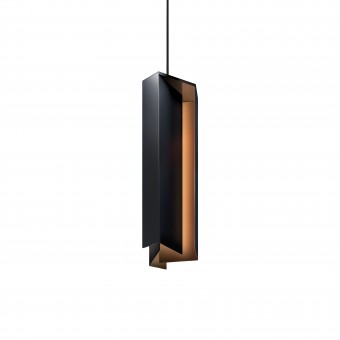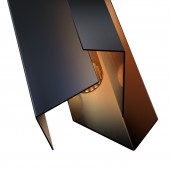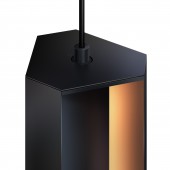
| THE AWARD |
| CATEGORIES |
| REGISTRATION |
| SUBMIT YOUR WORK |
| ENTRY INSTRUCTIONS |
| TERMS & CONDITIONS |
| PUBLICATIONS |
| DATES & FEES |
| METHODOLOGY |
| CONTACT |
| WINNERS |
| PRESS ROOM |
| GET INVOLVED |
| DESIGN PRIZE |
| DESIGN STORE |
| THE AWARD | JURY | CATEGORIES | REGISTRATION | PRESS | WINNERS | PUBLICATIONS | ENTRY INSTRUCTIONS |
Stanley 2701 Pendant Light by Tatiana & Nicolas Boon |
Home > Winners > Design #126882 >Interview |
 |
|
FS: What is the main principle, idea and inspiration behind your design?
TB: Our main source of inspiration was the mysterious black monolith from Stanley Kubrick's film 2001: A Space Odyssey. The matt finish evokes a mineral texture despite its aluminium construction. Its monolithic appearance and the lightness of its volumes recreate a feeling of floating in a mysterious, almost magical way. Our intention was that even when switched off, this 45cm high suspension offers a superb play of light and shadow throughout the day. When switched on, soft, glare-free gradations of light appear on its side surfaces and a direct, functional light is directed downwards. Stanley can be used individually or in groups to create a harmonious, well-balanced path of light through the space.
FS: What has been your main focus in designing this work? Especially what did you want to achieve?
TB: The luminaire was designed with particular attention to its unique geometry, allowing a variety of designs and lights to be created with the same geometric concept, resulting in the Stanley collection (S/2701, S/2702, S/2703). The complex assembly system developed has allowed us to create the impression of a luminaire with a monolithic appearance that can be fully dismantled, allowing easy access to the light source and easy repair if necessary, making it a durable suspension fixture. Environmentally friendly, the luminaire is made entirely from recyclable aluminium and offers a powerful LED light source.
FS: What are your future plans for this award winning design?
TB: We are currently developing its marketing.
FS: How long did it take you to design this particular concept?
TB: Between the design and the production we took more or less a good year.
FS: Why did you design this particular concept? Was this design commissioned or did you decide to pursuit an inspiration?
TB: This project was born out of a specific order from a client. The luminaire had to be very light, given its size of 45 cm. Only aluminium offered the ecological and physical characteristics that were necessary for this project. As aluminium does not have the best welding properties, we developed a seamless assembly system that gives the object a monolithic appearance.
FS: Is your design being produced or used by another company, or do you plan to sell or lease the production rights or do you intent to produce your work yourself?
TB: No, this project belongs to us, and for the moment we have edited it ourselves. But we are of course open to proposals for its future marketing.
FS: What made you design this particular type of work?
TB: I love lights, what I look for is first of all the beauty of the object and the play of shadows that the light produces, even when it is switched off. When lit, it unfolds all its magic.
FS: Who is the target customer for his design?
TB: This work is targeted at individuals but can also be directed at companies.
FS: What sets this design apart from other similar or resembling concepts?
TB: I think that this concept stands out because of the research into the play of light and shadow of the object itself when it is switched off. We wanted to evoke a monolith around which the sunlight dances throughout the day. When night falls, it then produces its own light and shadows.
FS: How did you come up with the name for this design? What does it mean?
TB: The mysterious black monolith from Stanley Kubrick's film 2001: A Space Odyssey inspired us to create this work, which is why we named the lamp Stanley in homage to the director. The 27 was chosen because the pallets were inclined at 27° and the 01 because it is the 01 model.
FS: Which design tools did you use when you were working on this project?
TB: First of all, we made a multitude of sketches to find the geometry that would allow us to evoke the monolith while offering the desired light characteristics. The numerous models allowed us to reveal all the problems linked to the rigidity, the assembly and the inclination of the slabs necessary for a perfect light. The 3d allowed us to calculate the ideal proportions of the luminaire in the space and to define the shadow play of the switched-off luminaire.
FS: What is the most unique aspect of your design?
TB: I think the unique aspect of this luminaire is its geometry which has allowed us to create a variety of different designs and lighting with the same geometric concept, resulting in the Stanley collection (S/2701, S/2702, S/2703).
FS: Who did you collaborate with for this design? Did you work with people with technical / specialized skills?
TB: My wife and I work together. She has contributed to the development of this work.
FS: What is the role of technology in this particular design?
TB: Manufactured from black anodised aluminium for optimum weight, the Stanley suspension luminaire consists of folded aluminium slabs. Made of black anodised aluminium for optimum weight, the whole luminaire has been designed without any welding points, giving the impression of a monolithic shape. The whole unit is held together by an invisible screw system. The matt, anodised finish evokes a mineral texture. The powerful LEDs integrated in the heart of the blades create a perfect symbiosis between the design and the light source.
FS: Is your design influenced by data or analytical research in any way? What kind of research did you conduct for making this design?
TB: To evoke Stanley Kubrick's rectangular monolith, we had to find a geometry that was close to the rectangle but allowed us to integrate the constraints linked to the diffusion of an optimal light. A direct and functional light, oriented downwards, not dazzling, soft and pleasant towards the sides.
FS: What are some of the challenges you faced during the design/realization of your concept?
TB: The biggest challenge during the design and realization was dealing with the problems related to the rigidity, assembly and inclination of the slabs necessary for perfect light.
FS: How did you decide to submit your design to an international design competition?
TB: It was because of the many positive comments about the product that we decided to enter the international design competition. But it was my wife who took the decision and initiated the initiative.
FS: Thank you for providing us with this opportunity to interview you.
A' Design Award and Competitions grants rights to press members and bloggers to use parts of this interview. This interview is provided as it is; DesignPRWire and A' Design Award and Competitions cannot be held responsible for the answers given by participating designers.
| SOCIAL |
| + Add to Likes / Favorites | Send to My Email | Comment | View Press-Release | Translations |





